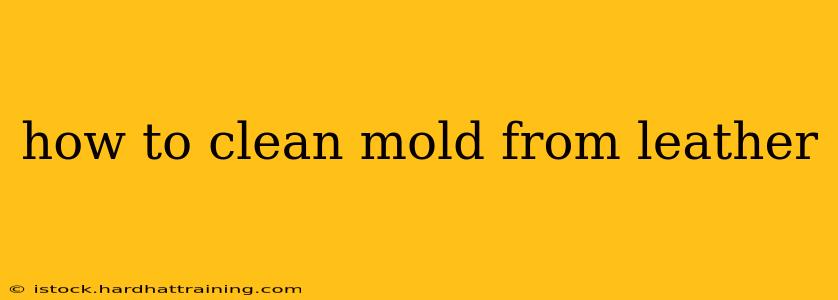Mold on leather is unsightly and can damage the material if left untreated. Fortunately, with the right approach and gentle cleaning methods, you can often successfully remove mold from your leather goods, restoring their appearance and extending their lifespan. This guide provides a step-by-step process and answers frequently asked questions about cleaning mold from leather.
What Causes Mold on Leather?
Mold thrives in damp, dark environments. Leather items stored in humid basements, attics, or areas with poor ventilation are particularly susceptible. Spills that aren't properly cleaned, or prolonged exposure to moisture, can also create the perfect breeding ground for mold. Understanding the cause is the first step in preventing future mold growth.
Is it safe to clean mold from leather myself?
Yes, but proceed with caution. Mold can cause allergic reactions in some people, so wearing gloves and a mask is crucial during the cleaning process. Always test any cleaning solution on an inconspicuous area of the leather first to ensure it doesn't damage the material. If the mold infestation is extensive or you're unsure about the cleaning process, consider seeking professional leather cleaning services.
How do I clean mold off leather effectively?
The best approach involves a multi-step process:
1. Preparation:
- Safety First: Wear gloves and a mask to protect yourself from mold spores.
- Assessment: Evaluate the extent of the mold infestation. Minor surface mold is easier to tackle than deep-seated mold.
- Ventilation: Ensure good ventilation in the area where you're working.
- Gather Supplies: You'll need soft cloths, a bowl of lukewarm water, mild dish soap (or specialized leather cleaner), a soft-bristled brush (an old toothbrush works well), and possibly a leather conditioner.
2. Cleaning:
- Gentle Cleaning: Mix a small amount of mild dish soap with lukewarm water. Dip a soft cloth into the solution, wring it out thoroughly to avoid soaking the leather, and gently wipe the affected areas.
- Brush Gently: For stubborn mold, use a soft-bristled brush to gently scrub the affected areas in a circular motion. Avoid harsh scrubbing, which can damage the leather.
- Rinse: Use a clean, damp cloth to rinse away the soap residue. Wring the cloth out thoroughly before wiping.
- Dry Thoroughly: Allow the leather to air dry completely in a well-ventilated area, away from direct sunlight or heat. Stuffing the item with clean towels can help absorb moisture.
3. Conditioning (Optional but Recommended):
- Leather Conditioner: Once the leather is completely dry, apply a leather conditioner to replenish moisture and help restore its suppleness. Follow the instructions on the conditioner's packaging.
What should I use to clean mold from leather?
Avoid harsh chemicals like bleach or strong solvents, as these can damage the leather. A mild dish soap and water solution is usually sufficient for surface mold. For more severe mold or valuable leather goods, consider using a commercially available leather cleaner specifically designed for mold removal, or consulting a professional.
How do I prevent mold from growing on leather?
Prevention is key! Here's how to keep your leather goods mold-free:
- Proper Storage: Store leather items in a cool, dry, and well-ventilated area.
- Regular Cleaning: Regularly wipe down leather items with a damp cloth to remove dust and dirt, preventing mold buildup.
- Immediate Spill Cleanup: Address spills immediately. Blot up any liquid immediately with a clean cloth and allow the leather to air dry completely.
- Dehumidifier: Consider using a dehumidifier in damp areas to control moisture levels.
Can I use vinegar to clean mold from leather?
While vinegar is a natural cleaning agent, it’s not recommended for cleaning leather. Vinegar is acidic and can damage the leather's finish, leading to discoloration or weakening of the material.
By following these steps and preventative measures, you can effectively clean mold from leather and protect your valuable leather goods for years to come. Remember to always prioritize safety and test any cleaning solution on a small, hidden area first. If you're dealing with extensive mold damage or have concerns about cleaning delicate leather items, it's best to consult a professional leather cleaner.
